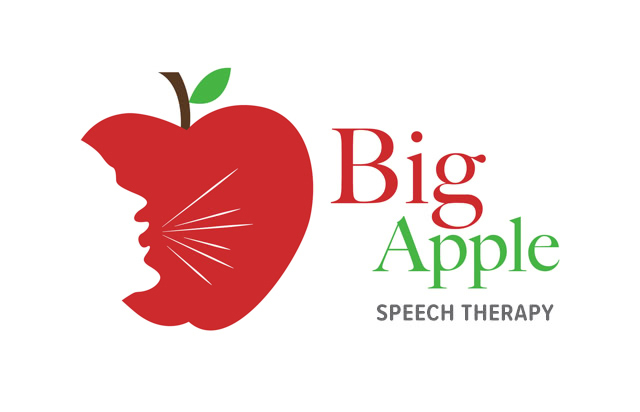Communication is the
Beginning of Understanding
John Smith, a fifteen-year seven month-old male, was referred to Big Apple Speech Therapy, LLC by V. H., Ph.D. for a complete speech and language evaluation. John’s parents accompanied him to the evaluation and reported concerns regarding John’s language processing skills and reading comprehension.
According to Dr. H’s report, John was the result of a full term pregnancy and uncomplicated delivery. He was colicky and irritable infant, but otherwise slept and fed well. He was reported to meet his developmental milestones at expected ages and there were no developmental concerns in his early childhood. John lives at home with his parents and one older sibling in an English-speaking household. There is a reported family history of learning problems in a paternal uncle. John is prescribed the medication Zetia for high cholesterol, which is common in the family, but otherwise he is in good health. His hearing and vision were tested last in eighth grade, with normal results. There is no history of head injury, hospitalization, or other medical concerns. Recently, he has had some troubles sleeping. It takes him over an hour to fall asleep at night and he is getting a total of about seven hours of sleep during the weekdays.
Currently, John is a sophomore at PCDS. According to the family, John has difficulty with reading comprehension, and understanding and remembering class lectures and homework. Additionally, he can be disorganized and unfocused.
John was accompanied to the evaluation by his parents and separated from them without difficulty. The evaluation was administered over the course of two sessions. John was evaluated using formal and informal measures. The following tests were used during this evaluation:
• Clinical Evaluation of Language Fundamentals – 5th (CELF-5)
• Test of Problem Solving Adolescent – 3rd (TOPS-3)
• Test of Auditory Processing Skills – 3rd (TAPS-3)
• The Word Test -2
• Receptive One-Word Picture Vocabulary Test (ROWPVT)
• Expressive One-Word Picture Vocabulary Test (EOWPVT)
John presented as a sweet, quiet, young man who exhibited typical teenage behaviours. The evaluation was administered over the course of two sessions. John worked well with little need for verbal reinforcements. He appeared to try his best, even when the content and/or language became challenging. He maintained adequate attention throughout the evaluation. John appeared to work to the best of his ability during the evaluation, and the results of this evaluation are felt to be a valid measure of his communicative abilities.
Informal assessment of John’s oral structure, voice, fluency and articulation posed no concern at this time.
CLINICAL EVALUATION OF LANGUAGE FUNDAMENTALS -5 (CELF-5)
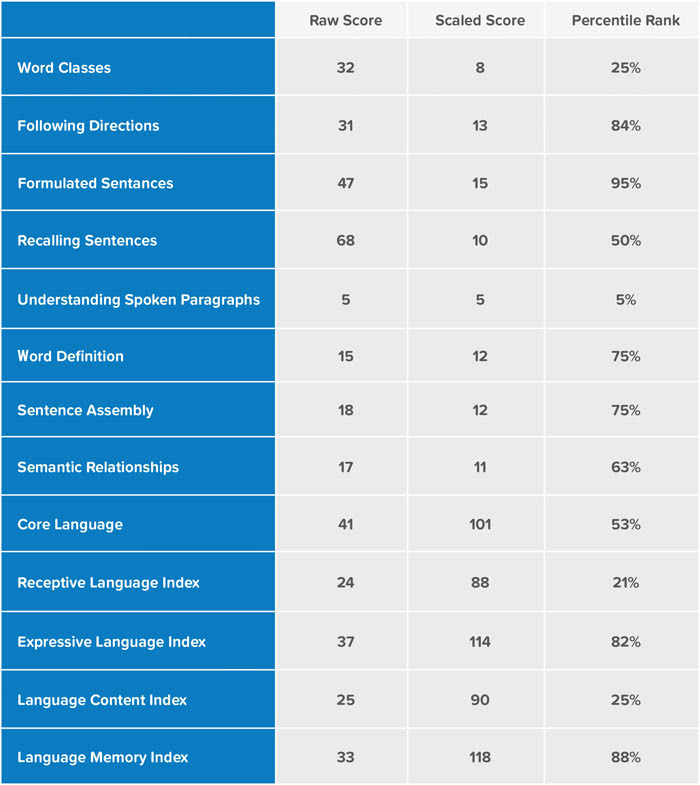
CORE LANGUAGE SCORE
John was administered four core subtests of the CELF-5 from which his Core Language Score was derived. The core language score includes the following subtests: Recalling Sentences, Formulated Sentences, Understanding Spoken Paragraphs and Semantic Relationships. The Core Language score is considered to be the most representative measure of John’s language skills and provides a reliable way to quantify a student’s overall performance.
The Core Language score has a mean of 100 and a standard deviation of 15. A score of 100 on this scale represents the performance of the typical student of a given age. Average percentile rank is 50{c8b63753022f93b45e9bdf42c3a69ad4fccd7772ffb32f0cedf9714276564f8f}.
John received a Core Language score of 101 (percentile rank = 53). According to the standard score, John is within normal limits in comparison to his peers. However, when the other total language scores were examined, John showed relative difficulties with Receptive Language and Language Content, mainly due to his difficulties responding to questions about short stories.
The Receptive Language Index is measure of listening and auditory comprehension. The subtests of Word Classes, Understanding Spoken Paragraphs and Semantic Relationships were administered to assess John’s listening and comprehension skills. The scores from these subtests are combined to yield a receptive language index score. John received a standard score of 88 (Mean=100; SD= +/- 15), for a percentile ranking of 21{c8b63753022f93b45e9bdf42c3a69ad4fccd7772ffb32f0cedf9714276564f8f}. This score is considered to be in the below average range in relation to John’s same-aged peers.
The Expressive Language Index is an overall measure of expressive language skills. The subtests of Recalling Sentences, Formulated Sentences and Sentence Assembly were administered to assess John’s expressive language ability. The scores from these subtests are combined to yield an expressive language index score. John received a standard score of 114 (Mean=100; SD= +/- 15) for a percentile ranking of 82{c8b63753022f93b45e9bdf42c3a69ad4fccd7772ffb32f0cedf9714276564f8f}. This score is considered to be in the above average range in relation to John’s same-aged peers.
The Language Context Index is a measure of various aspects of semantic development, including vocabulary, concepts and category development, comprehension of associations and relationships among words, interpretation of factual and inferential information presented orally and the ability to create meaningful, semantically and syntactically correct sentences. The subtests of Word Classes, Understanding Paragraphs and Sentence Assembly were given to assess these aspects of semantic development. The scores were combined to derive a language content index score. John received a standard score of 90 (Mean=100; SD= +/- 15) for a percentile ranking of 25{c8b63753022f93b45e9bdf42c3a69ad4fccd7772ffb32f0cedf9714276564f8f}. This score is considered to be in the below average range in relation to John’s same-aged peers.
For the Language Context Index, John evidenced significant difficulties answering wh-questions based upon short stories. John had difficulties identifying the mean idea, finding important details, sequencing, inferencing and making prediction. This shows John’s difficulties with language processing.
The Language Memory Index is an overall measure of receptive and expressive memory tasks. The subtests of Following Directions, Recalling Sentences, and Formulated Sentences were utilized to derive a language memory index. John received a standard score of 118 (Mean=100; SD= +/- 15) for a percentile ranking of 88{c8b63753022f93b45e9bdf42c3a69ad4fccd7772ffb32f0cedf9714276564f8f}. This score is considered to be in the above average range in relation to John’s same-aged peers. This shows that John’s difficulties are not a short-term memory issue.
TEST OF PROBLEM SOLVING (ADOLESCENT) – 3 (TOPS-3)
The Test of Problem Solving-3 Adolescent (TOPS-3) was administered to assess the John’s language-based critical thinking. This test allows one to examine discrete skills that come from the foundation of thinking, reasoning, and problem solving abilities. This test measured critical thinking abilities based on language strategies using logic and experience. This test assesses the individual’s ability to make inferences, determine solutions, problem solve, interpret perspectives and transfer insights. The subtests require the individual to pay attention to what they heard and read, think about the problems with a purpose in mind and process this information. Each subtest has a mean of 100 and a standard deviation of 15. A score of 100 on this scale represents the performance of the typical student of a given age.
Below is an example to help the reader understand the types of test items that were used to assess critical thinking and problem solving skills:
Passage: Sojourner Truth was an African American slave set free in 1827. She believed all people should have equal rights and she spoke out to earn equal voting rights for women. Sojourner Truth also gave speeches to convince all Caucasian men and women that African Americans were equal in every way to Caucasians.
Making Inferences: Why do you think Caucasians did not grant equal rights to African Americans? A specific response from the client would have included a reference to fear, racism, ignorance, or thinking that they were different.
Determining Solutions: What do you think Sojourner Truth did to convince Caucasians that African Americans were equal to Caucasians?
Problem Solving: What was one problem with slavery?
Interpreting Perspectives: How do you think other African Americans felt about Sojourner Truth?
Transferring Insights: What issues in today’s world can you think of that are like Sojourner Truth’s story?
John received a total test score of 79, and a percentile rank of 8{c8b63753022f93b45e9bdf42c3a69ad4fccd7772ffb32f0cedf9714276564f8f}. John’s scores were as follows:
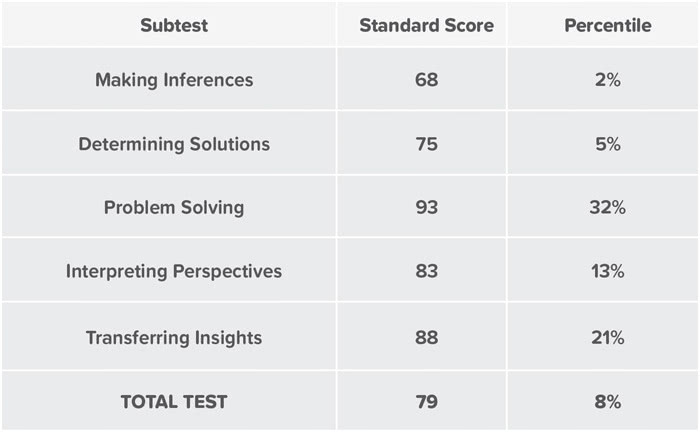
Mean=100; SD= +/-15
The Making Inferences subtest was administered to assess John’s ability to give a logical explanation about a situation, combining what he knows or can see with previous experiences and background information. On this subtest he achieved a standard score of 68, for a percentile rank of 2{c8b63753022f93b45e9bdf42c3a69ad4fccd7772ffb32f0cedf9714276564f8f}. This score is in the significantly below average range for same aged peers.
The Determining Solutions required John to give a logical solution for some aspect of a situation presented in the passage. In this area, he achieved a standard score of 75, for a percentile rank of 5{c8b63753022f93b45e9bdf42c3a69ad4fccd7772ffb32f0cedf9714276564f8f}. This score is in the significantly below average range for same aged peers.
The Problem Solving subtest involved recognizing the problem, thinking of alternative solutions, evaluating these options and stating an appropriate solution for a given situation. It also includes stating how to avoid specific problems. John achieved a standard score of 93, for a percentile rank of 32{c8b63753022f93b45e9bdf42c3a69ad4fccd7772ffb32f0cedf9714276564f8f}. This score is considered as below average when compared to same age peers.
The Interpreting Perspectives subtest required John to leave behind his own thoughts about an issue and “enter the world” of someone else. John achieved a standard score of 83, for a percentile rank of 13{c8b63753022f93b45e9bdf42c3a69ad4fccd7772ffb32f0cedf9714276564f8f}. This score is in the significantly below average range for same aged peers.
The Transferring Insights subtest requires John to transfer insights into familiar and unfamiliar contexts. For this subtest, John must listen to a situation and look back to examine it from his perspective of past experiences. Additionally, John must look forward to see how another person might think about the situation. John achieved a standard score of 88, for a percentile rank of 21{c8b63753022f93b45e9bdf42c3a69ad4fccd7772ffb32f0cedf9714276564f8f}. This score is considered as below average when compared to same age peers.
John achieved a total test standard score of 79, for a percentile rank of 8{c8b63753022f93b45e9bdf42c3a69ad4fccd7772ffb32f0cedf9714276564f8f}. This score is considered to be significantly below average range in comparison to other children his same age. Based upon individual subtests, John has difficulties applying higher level thinking skills, such as taking in others perspectives and transferring insights. He also experiences challenges when determining all the necessary details and critical elements of information in order to make accurate inferences in specific situations and determining appropriate solutions.
TEST OF AUDITORY PROCESSING SKILLS – 3 (TAPS-3)
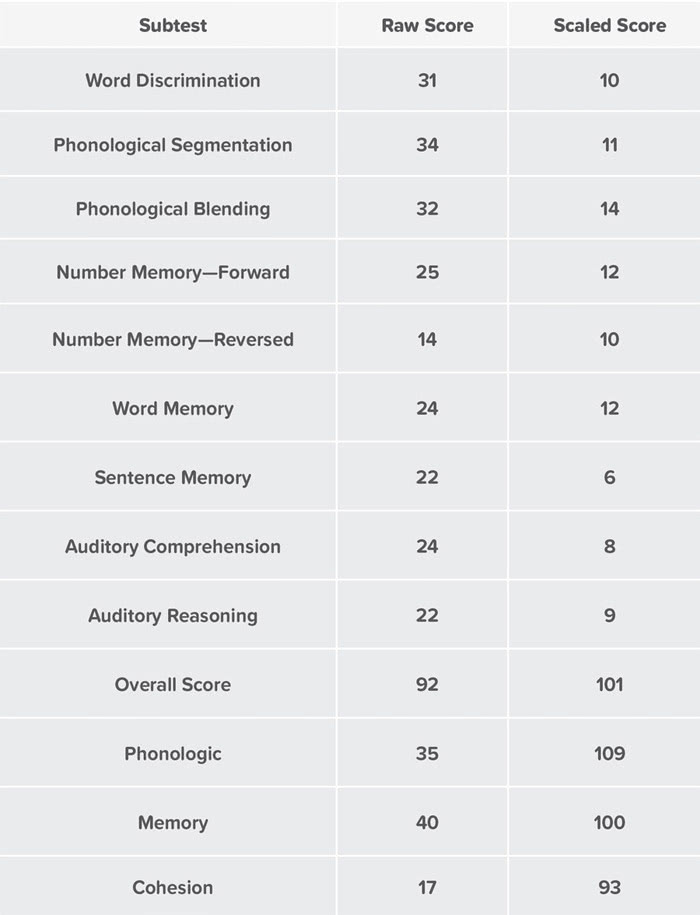
The TAPS-3 subtests were designed to provide the types of information necessary to assess the processing of auditory information that pertain to the cognitive and communicative aspects of language. The first three TAP-3 subtests (Word Discrimination, Phonological Segmentation, and Phonological Blending) provide quick assessments of very basic phonological abilities that allow one to discriminate between sounds within words, segment words into morphemes, and blends phonemes into words. All of these skills are important for understanding language and learning to read.
The next four TAPS-3 subtests (Number Memory Forward, Number Memory Reversed, Word Memory, and Sentence Memory) are measures of basic memory processes, including sequencing.
Finally, Cohesion is the combination of the last subtests (Auditory Comprehension and Auditory Reasoning). These two subtests are the most complex, and assess auditory cohesion. This is a higher-order linguistic skill that requires John not only to understand exactly what was said but also to be able to use inferences, deductions and abstractions to understand the meaning of a passage. In the Auditory Comprehension subtest, sentences or short stories were read to John who then had to answer questions about what he just heard; the correct answer is contained within the passage. The questions asked about the passages in the last subtest, Auditory Reasoning, cannot be answered correctly using only the words presented in the passage; rather, John had to be able to understand and use more complex language constructions to answer the queries (e.g., inferences, predictions).
John evidenced average to above average skills in all areas of the TAP-3, with the exception of Sentence Memory. He was able to
segment and blends sounds, as well as to memorize chucks of basic information. While his scores for Auditory Cohesion (e.g., auditory comprehension and auditory reasoning) were still within the normal limits, they were significantly decreased from his other Indices. Based upon these scores, John may have difficulties focusing primarily on the higher-order functions involved in using auditory information in the understanding of spoken language.
THE WORD TEST -2 (ADOLESCENT)
The Word Test -2 (Adolescent) was administered to assess John’s expressive vocabulary and semantic skills. The following scores were obtained:
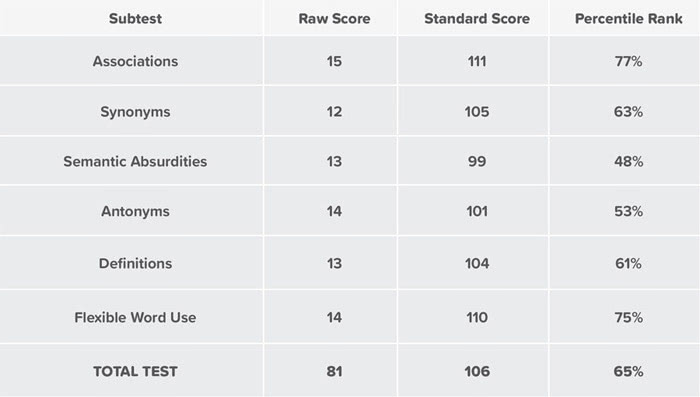
Based upon the standard scores on The Word Test -2, John does not evidence difficulties in the area of expressive vocabulary and semantics. His overall score was 106 with a percentile range of 65{c8b63753022f93b45e9bdf42c3a69ad4fccd7772ffb32f0cedf9714276564f8f}
The Receptive One-Word Picture Vocabulary Test was administered to assess John’s comprehension of single words. The following scores were obtained:
Raw Score: 123
Standard Score: 92
Percentile Rank: 30{c8b63753022f93b45e9bdf42c3a69ad4fccd7772ffb32f0cedf9714276564f8f}
Based upon the standard score, John demonstrates average comprehension for single word vocabulary.
The Expressive One-Word Picture Vocabulary Test was administered to assess John’s expressive single word vocabulary. The following scores were obtained:
Raw Score: 117
Standard Score: 92
Percentile Rank: 30{c8b63753022f93b45e9bdf42c3a69ad4fccd7772ffb32f0cedf9714276564f8f}
Based upon the standard score, John demonstrates average expressive for single word vocabulary.
John participated well during all tasks administered when provided with minimal verbal reinforcement to remain on task and persevere. He was quiet yet cooperative. He appeared to work to the best of his ability throughout the evaluation.
In the area of language comprehension, John demonstrated average to below average scores across all subtests. He demonstrated age-appropriate skills in the area of word classes, accurately choosing words that were related, as well as demonstrated understanding of various sentence structures. John did evidence significant difficulties with answering questions based upon stories presented orally and in writing. He did evidence adequate vocabulary comprehension. This shows that John has an adequate foundation of language skills, however he is unable to access it when needing to use higher-order thinking skills.
In the area of overall expressive language skills, John demonstrated average to above average scores. John demonstrated average skills in the area of expressive vocabulary and sentence formulation. He evidenced adequate skills for grammar and syntax.
Results from the ROWPVT and the EOWPVT indicate John’s core lexicon was well developed for comprehension and expression of pictured semantic vocabulary. This language foundation should serve as the basis for other language abilities. According to the CELF-5 and the TAPS-3, results indicated that John’s short-term memory for both related and unrelated material was commensurate with age expectations. Inadequate short term working memory did not appear to be a factor in his language performance deficits.
John did evidence significant difficulties with problem solving, perspective taking and transferring ideas on the TOPS-3. John struggled to consistently provide appropriate or detailed answers relative to the questions presented. Instead, John provided either a basic/general answer or an odd/irrelevant response in relation to information provided. He also experienced challenges when determining all of the necessary details and critical elements of information in order to make accurate inferences in specific situations. The language processing demands to integrate, semantic, syntactic and pragmatic skills appeared extremely problematic for John.
John evidenced difficulties with creating meaning from oral language and text; answering questions about the content of the information given; and critical thinking skills to interpret beyond the given information. Additionally, John demonstrated significant difficulty with higher-level thinking skills, which may cause him to experience difficulty with analogical reasoning required at higher-levels of education. For example, he may exhibit difficulties with note taking, reading comprehension, answering questions and figurative language.
Language processing is the ability to attach meaning to auditorily received information of increasing cognitive complexity. Language processing presumes adequate development in fundamental receptive and expressive language abilities (e.g., general vocabulary, concepts, articulation, syntax, etc. The deficit is subtle and usually shows as academic demands become more auditory modality based. Early school programming relies on multimodality teaching (e.g., combination of visual, tactile and auditory stimuli). A child with language processing deficits is able to compensate for auditory weaknesses with visual and experiential modalities. As the auditory demand increases and academic tasks become more abstract, the student begins experiencing difficulty and frustration.
Based upon the gaps between John’s cognitive functioning, which is in the average to above average range and his current high-level language functioning, which is in the significantly below average to average range, John require some short-term intervention.
Areas of focus should be as follows:
• Improve John’s higher-level thinking skills through analogical reasoning skills
• Improve John’s ability to respond to wh-questions where critical thinking is involved
• Improve John’s expressive language formulation for increased specificity when explaining, describing and expressing with increased complexity of language
• Improve John’s oral listening skills so that he is able to describe events and tell stories in an organized fashion, outing his thoughts in the correct order and getting to the point when speaking.
